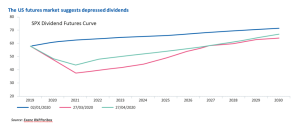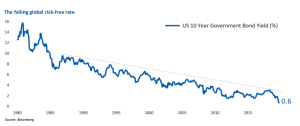
In our first-quarter commentary, we highlighted the likelihood that dividends would be lower this year than in the past, another casualty of the ongoing coronavirus. Here we examine the question of income more closely and outline our approach to finding sustainable growth.
Coronavirus: problems incoming
While any coronavirus downturn may prove short-lived, it is likely to be ‘off the charts’ in terms of its severity. The disease itself and the government countermeasures have effectively halted swathes of the global economy. The future is extremely uncertain given the unknown length of lockdowns in countries around the world, let alone their potential re-imposition.
In this context, companies find themselves caught between scarce demand today and a potential return to ‘normal’ by the end of the year. An increasing number of companies have cancelled, suspended or deferred dividends in an effort to protect their own cash flow and balance sheets.
To date, over 60% of the UK’s largest hundred public companies have cut their dividends for the next 12 months. By comparison, even in the teeth of the last financial crisis, dividend expectations only fell by 10%.
This matters because progress for the UK stock market is peculiarly reliant on income. Since the start of this century to the end of March 2020, the FTSE 100 has risen by 61%; a lacklustre total return of c.2.5% per annum. However, strip out the dividends and the same companies have fallen by over 18% in share price terms.

Turning overseas, in Europe over 50% of the largest 600 companies have reduced their dividends. In the US, where dividend payout ratios tend to be lower, investors expect to receive 70 cents for every dollar they received last year. Furthermore, for all the talk of swift recoveries, current estimates are that company payouts will remain depressed in Europe for the next decade and take roughly eight years to return to 2019 levels in the US.
Dividends divided
Some companies already had poor prospects and weak balance sheets and management have sought the excuse of ‘herd immunity’ to cut ill-supported dividends.
However, the roster also includes companies in strong positions where precautionary action has been taken. Examples include Rentokil which cut its dividend outright to preserve liquidity and reduce risk, while LVMH has lowered its dividend by 30% and one senses that the company prefers to be cautious and independent than potentially beholden to the French government.
Indeed, the decline in dividends has been exacerbated by governments limiting payouts from companies that receive state aid during the crisis. For example, the French government has invited all companies in which the state has ownership not to pay dividends (a wide-ranging list including the likes of EDF, Orange and Renault). In the UK, the Prudential Regulation Authority has instructed banks to suspend payments to protect financial resilience; a big step given banks comprised 13% of UK dividends last year but preferable, perhaps, to the forced equity raises of 2008.
Bond yields under pressure
The problem is not confined to equities. Moving up the capital structure from shares to bonds, yields have shrunk as investors have been willing to pay higher and higher prices for the same assets.
This is visible in the US 10-year government bond which promises $1.50 of coupons per annum and the repayment of $100 in 10 years’ time. In mid-February, this bond cost just under $100; today it costs $108. Put differently, the bond’s yield has more than halved from c.1.5% to 0.6%, and this is before the effects of tax or inflation.

This problem is the same one experienced by ordinary savers: the action taken to keep the economy afloat has crippled the interest rates on cash. In turn, the income from riskier assets is structurally lower, despite such assets offering greater uncertainty and the possibility of higher losses.
The JH&P approach
At JH&P we have always viewed income as a central component of the returns we deliver for clients. Since our firm began in 2010, we have generated broadly two-thirds of our returns from capital appreciation and one-third from income.
For our private clients, this reflects our awareness that securing an income after tax that exceeds budgeted expenditure is one of the hallmarks of financial independence. For our charities and trusts, income is often even more critical, being the mainspring around which all other activities are wound.
“A man’s true wealth is his income, not his bank balance” – Fred Schwed, Where Are the Customers’ Yachts
Fortunately, generating income requires no deviation from our investment principles. All of our portfolios have a core exposure to equities, with balancing assets held as appropriate for the risk profile. These equities, whether held directly or through third-party investment funds, represent reasonably-valued companies with attractive operating models that good management can make even better over time. The companies typically have proven track records, high returns on invested capital and strong balance sheets. This means they often generate more cash than they need to reinvest in future growth and this ‘extra’ cash is returned to shareholders, usually in the form of dividends.
Given the symptoms, what’s the treatment?
We have used the current turbulence to ‘double-down’ on the qualities we favour and which we think provide a bedrock of not only sustainable income but also dividend growth for the years to come.
The pandemic will affect the way we think and behave. Our view is that these behavioural changes will more immediately accelerate the structural trends already in motion rather than create new trends from scratch. For example, the US Department of Defense recently announced that it is moving from emails to Microsoft Teams, the collaborative working tool. Where inertia might have delayed adoption for years, the change is happening in weeks. Microsoft has been one of our preferred names, with a well-protected and growing dividend.
Indeed, large changes are cemented during recessions. As NYU Stern professor Aswath Damodaran has noted, people often forget how much of Amazon’s success was due to the dot com bust (rather than the boom) of 2001 that wiped out many online competitors. So, we are focused on companies from Experian and Unilever to JPMorgan and Visa which we expect will come out of today’s downturn stronger than they went in.
Equally important to the long-term sustainability of income is something that we have never done – reached for yield. The high yields available on many assets today are warning flags signalling that the income may not be paid. This is particularly true of companies reliant on consumption (travel, leisure, hotels) where recovery is predicated on people feeling confident again. These are potential ‘income traps’ where the dividends are uncertain and capital could be permanently lost if the earnings power of such companies proves impaired.
This principle spans the asset classes. We foresaw the risk in property funds of reduced income and the inability to sell if everyone tried to exit at once. Similarly, we have been cautious on the more exotic parts of the fixed income markets, especially as investors’ discipline waned in the reach for returns and ‘covenant-less’ bonds replaced the ‘covenant-lite’ counterparts of yesteryear.
Our caution meant foregone gains in good years but has proved warranted during this crisis as liquidity in the bond market has evaporated. We try to remember that there is no rule stating that an investor must pursue every last pound of profit regardless of the risk.
Finally, we continue to think of the long term, even if keeping such perspective is difficult when locked inside a personalised Groundhog Day. We have noted that governments may be tempted to influence companies long after the coronavirus threat recedes. By avoiding businesses that are likely to need public sector support, we hope to avoid the risk of cash flows being subordinated to repaying the government and of reduced flexibility to manage capital allocation and employee relations. Companies that stay independent are likely to get stronger relative to those going cap in hand, with positive implications for shareholder payouts.
The bottom line
Structural changes mean that the same portfolio of assets that might have generated 3–4% of income per annum in the past may offer only 2–3% today. This will be difficult for many investors, but the risks of chasing income are clear; capital values can fall while the income may not be paid after all.
In today’s uncertain world, it is not possible to provide clear guidance on the income that we expect our portfolios to generate this quarter or next. This picture will become clear as we move through the weeks and months to come. Until then, we continue to examine each investment that we hold for clients to assess where any drops in income are likely to be permanent and where they could be temporary. Over the longer term, we remain confident that by investing in the highest quality assets, our portfolios have the greatest odds of sustainably growing income, and capital value, when other high-promising assets fall by the wayside.
By Thomas Allsup
Stocks named here have been long-term holdings. You should not infer that we are recommending individuals buy them.
Opinions and views expressed are personal and subject to change. No representation or warranty, express or implied, is made or given by or on behalf of the Firm or its partners or any other person as to the accuracy, completeness or fairness of the information or opinions contained in this document, and no responsibility or liability is accepted for any such information or opinions (but so that nothing in this paragraph shall exclude liability for any representation or warranty made fraudulently).
The value of an investment and the income from it can go down as well as up and investors may not get back the amount invested. This may be partly the result of exchange rate fluctuations in investments which have an exposure to foreign currencies. You should be aware that past performance is not a reliable indicator of future results. Tax benefits may vary as a result of statutory changes and their value will depend on individual circumstances.
James Hambro & Partners LLP is a Limited Liability Partnership incorporated in England and Wales under the Limited Liability Partnerships Act 2000 under Partnership No: OC350134. James Hambro & Partners LLP is authorised & regulated by the Financial Conduct Authority and is an SEC Registered Investment Adviser. Registered office: 45 Pall Mall, London, SW1Y 5JG. A full list of partners is available at the Partnership’s Registered Office.
